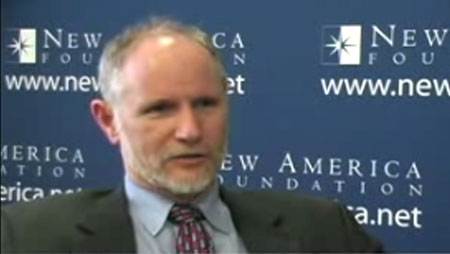Posted by CHPRE Staff
Research
Tuesday, October 16th, 2012
Our active research projects are of three types: Health Policy Research, Health Reform Implementation, and Health Policy Communication. Click Active Projects for descriptions of each of our current projects.
The purpose of health policy research is to improve health policy debates, policy development, and implementation. CHPRE work is directed at the national, state, and local levels, for all three have unique roles to play in enabling health policy to improve real people’s lives. We research both health insurance and delivery system topics, wherein population health is an increasingly important focus since comprehensive health reform has become national policy (at least for now).
Posted by CHPRE Staff
Research
Thursday, August 25th, 2011

Len Nichols CHPRE
When Len was recently interviewed by the Free Lance-Star, Len stressed the importance of changing the way health care is delivered and paid. If this is not changed, “half of the families in America will be spending about a third of their income on health care”. Even if the bill is repealed, the reform legislation may not survive when challenged in court. Either way, it demonstrates that the nation’s health care system is not on a sustainable path.
In the interview, Len mentioned that “health care costs are growing faster than economy-wide productivity and faster than income”. Health care is unaffordable for Americans and will continue to be unaffordable if nothing is done. To demonstrate how unaffordable health care is becoming, Len highlighted that the “rise in per-capita income falls behind the increase in health care costs and health insurance premiums”. In Virginia, per-capita income has grown only 4%/year for the past 10 years while health care costs have risen 6%/year.
Posted by CHPRE Staff
Research
Thursday, September 23rd, 2010
Health Insurer WellPoint Inc. originally stated that there would be a 39% increase for individual plans. However, now they will suffer a $100 million dollar loss in California since there was error in the insurer’s filing and such a high rate is unjustifiable. Angela Braly, the chief executive of the company says that the price increases are due to the “rising cost of care and demands for higher reimbursement from providers–> creating higher premiums”, she also stated that the new health law does not do enough to control costs. Even though WellPoint’s Anthem Blue Cross in California wants to bring down the increase to 14%, it is still too high for consumers.
Len says that WellPoint has made their point clear, the insurer repeatedly says they cannot control costs and that is causing the increase in plan prices. Even with WellPoint refiling their rate to 14%, there is still a health cost problem. Medical costs have only continued to increase in California this year according to company executives, with healthy people dropping coverage. McKinsey & Co. believes that medical costs in America will rise between 7% and 9% for 2010.
Wall Street’s unhappy reaction to the price increase was evident when stock prices fell 10% in one day after hearing that WellPoint proposed their intial rate increase of 39%. Even if it is as low as 14%, Wall Street will not be happy as it is still in the double digits and this will hurt WellPoint.
The new proposed rates will affect a larger number of policyholders, about 700,000. In the business consumer unit, Brian Sassi, the president and chief executive stated that “they filed rates that did not cover costs to move forward”. Other state regulators will be investigating the rate filings, but executives say that the situation in California is different and they would not establish “money losing rates in other markets”. WellPoint will file rates that cover cost next year. The Insurance Commissioner of California said he will be looking at the rate increases set forward very carefully.
Read the entire article here by subscribing to The Wall Street Journal.
Posted by CHPRE Staff
Research
Thursday, September 23rd, 2010
Below is a brief overview of Obama’s Proposal and the opposition to reform.
Visit the White House Website for Details
Brief overview of the President’s Bill:
- The Senate bill is the core of the President’s Proposal
- Middle class tax cut that will reduce premiums for families and small business owners, making coverage more affordable and accessible-reaching more than 31 million Americans
- A health insurance exchange will be set up so that Americans can choose from different insurance companies, increasing competition based on cost and quality. This will be the same options that Members of Congress have. With an insurance exchange, there will be more regulation and standardization on health insurance practices.
- More accountability to health care-insurance companies,rules that will prevent increasing premiums and denial of care (including pre-existing condition)
- In the first ten years, reform will reduce the deficit by $100 Billion
For detailed summaries of the actual bill, the KFF (Kaiser Family Foundation)comparison web page is better than most. For actual bill language, always visitThomas.
Bring the House and Senate Ideas Together:
- Allows for additional federal funding for all states to expand Medicaid
- Closes the Medicare “Donut Hole” coverage gap: Medicare stops paying for prescription drugs after the plan and beneficiary have spent $2830, Medicare starts to pay again after the out of pock expenses have reached $4550. Seniors end up paying full price for drugs and usually will not end up purchasing, harming their health
- Increases the excise tax for expensive health plans, $23,000 to $27,500, (2018, for all plans)
- Supports the provisions to eliminate fraud, abuse, and waste in Medicare and Medicaid
- Establish Health Insurance Rate Authority-will review unreasonable rate increases and unjustifiable health insurance practices
Topics of opposition:
-Abortion
-Mistrust between the Senate and the House
-Immigration
-Using reconciliation as a tactic
Posted by CHPRE Staff
Research
Thursday, September 23rd, 2010
Long before health reform will help businesses, Joe Wilson, a proprietor in Fredericksburg, VA with 107 employees, discusses its impact and high health care costs. He talks about the increased costs that would be effective immediately because under health reform, part-time employees will also qualify for health insurance benefits along with any employee’s adult dependent children under age 26. Joe realizes the need for health reform, but his concern is the cost, and he is not the only one worried about it.
Len Nichols shows his continued support for health reform by saying if this were a “government takeover”, the mandate would be “You are all on Medicare. It starts in July”. He strongly believes that health reform will become more popular as the provisions become more widely known. He stated that the complexity of health reform is because incentives, which are meant to impede the growth of health care costs, are a bit more difficult to explain than coverage expansion (what politicians focus their talks on). There is no question that the initial impact will be higher costs, but health reform will be beneficial in the future.
The article also mentions the results of the Health Connector and Utah who have set up exchanges. The Health Connector has decreased the number of insured since the launch of the program (13% in 2006 to 4% in 2008). However, this has been costly to the state and was more than estimated.
Another issue the article mentions that will arise with health reform is the shortage of primary care doctors in the near future. With the expansion of Medicaid in VA, one million residents would become eligible under the new law. A shortage of primary care doctors could be a problem for VA, especially since it ranks 48th for its level of Medicaid reimbursement. If fewer doctors accept Medicaid patients, it will be difficult to find a primary care doctor or keep the one you had. To address this issue, there are incentives to recruit more health care clinicians (primary care docs, nurses, NP’s, etc.).
The last part of the article discusses health reform and the establishment of accountable care organizations(ACO). Virginia Tech and Carilion Clinic are currently working on such a project. This model suggests that doctors, hospitals and insurers work together to coordinate care-a focus on preventative care and reward effective disease management practices. This will improve quality outcome and processes, however it has to involve the individual and make them take responsibility for their health as well.
Overall, health reform will require everyone at all levels to participate and become more actively involved in taking care of one’s own health to receive the maximum benefits out of health reform and life in general. To read more details of the article, see below.
Swallowing the Health-Care Pill-Virginia Business



